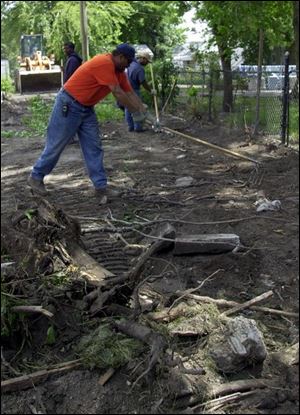
Ford pushes neighborhood cleanup
6/15/2002
City employees clean the alley behind the 1300 block of Hamilton Street.
Slowly backing his dark-green Jeep Liberty out of a trash-strewn alley off Nebraska Avenue, Mayor Jack Ford winces at the popping sound of a bottle breaking under the rear wheel.
“I hope I don't get another flat tire,” the mayor says as he continues to back out of the alley.
Mr. Ford's campaign to clean up neighborhoods also is causing some breakage of the political kind.
The mayor has ordered the community development corporations, which receive operating revenue from the city, to come up with goals for cleaning up neighborhoods.
City Council on Tuesday is expected to vote on a package of legislation that would:
This week, the mayor's staff floated a proposal to create neighborhood cleanup “SWAT” teams and borrow money from the housing demolition budget to fund it. That plan drew immediate criticism.
Still to come are proposals to buy trash containers for people who can't afford a new one, and initiatives that would include setting large trash containers in certain neighborhoods.
The city already sends crews with dump trucks and loaders from the division of streets, bridges, and harbor through every alley two or three times a year. This week, crews scoured alleys in the central city behind Belmont and Indiana avenues and Hamilton Street.
They picked up piles of yard and construction debris and old furniture.
The mayor recently stepped up the pressure on community development corporations to contribute to the effort.
Kathleen Kovacs, executive director of Neighborhoods In Partnership, a community development corporation in the Old West End, said the CDCs received a letter from Ford Weber, the acting director of neighborhoods, telling each of them to develop an annual cleanup plan.
Ms. Kovacs said the cleanups are normally handled by smaller groups in the CDCs' geographical area, including neighborhood associations and Block Watches.
“We have not historically planned the cleanups,” Ms. Kovacs, president of the Toledo CDC Alliance, said. “It would have been good to sit down and work together on a strategy.”
Sonya Harper, the president and chief executive officer of the Neighborhood Improvement Foundation of Toledo, Inc., said the mayor's expectations of the CDCs are legitimate.
“It's not a new directive. It's a reinforcement of what's been an expectation all along,” Ms. Harper said. NIFTI carries out neighborhood cleanups in conjunction with local groups. She said only three of the 13 city CDCs contracted with NIFTI to do neighborhood cleanups last year.
Neighbors in Toledo's central city, where meticulously kept homes often adjoin neglected dwellings, support the move.
Charlie Tate, a retired school maintenance worker at Penta County Vocational Technical School, has expanded his home at Vance Street and Forest Avenue over the years by adding lots on either side. His yard is a showpiece. Next door, weeds flourish.
He said keeping alleys clean has to be an individual's responsibility.
“If you put it in a paper bag and a dog rips the bag open you can't expect the garbage people to scoop it up,” he said. “Enforcing is the key word because it's the people themselves who should do most of the work because the city can't do everything.”
Nate and Kathy Ross bought a house in the 1500 block of Vance last year. They said they stopped allowing their two girls to walk the three blocks to Pickett Elementary School this school year because of the unsavory nature of one of the blocks along the way.
“I grew up in this neighborhood and I walked every day to school. There wasn't as much trash. This part of the city, I feel, gets the least amount of attention,” Mr. Ross said.
Most of his ideas have support on Toledo City Council.
Republican Councilman Gene Zmuda said the police, prosecutors, and courts have to follow through for a crackdown to be successful. In all of 2001, eight people were charged with illegal dumping, while as of May 31, none had been charged this year.
The administration told council in a memo that during the rest of 2002, there will be a “tremendous number” of citations issued.
Councilman Robert McCloskey said he does not support a proposal floated this week to divert up to $212,000 to neighborhood cleanups by reducing the housing demolition goal from 300 to 200.
“The No. 1 nuisance abatement problem in District 3 is tearing down nuisance houses,” Mr. McCloskey said.
Tooling around quiet and tree-shaded central city neighborhoods early one morning, Mr. Ford said a cleaner neighborhood would raise property values $5,000 or more and would give children a more positive outlook.
“How do kids feel about living in an area where blighted houses and illegal dumping are the mainstay,” Mr. Ford wondered.